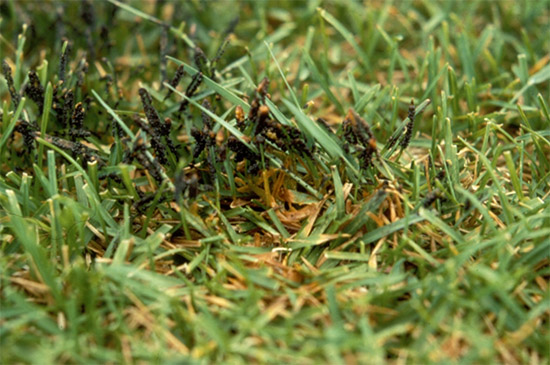Issue 8, June 14, 2016
Slime Molds in Turf
Temperatures jumped in the last week and rain has fallen or is predicted across most of the state. With warm, wet weather comes the possibility of slime molds, one of the stranger organisms we encounter in the Plant Clinic.

Slime mold on turfgrass. Note the dark crust on the surface of affected leaves.
Slime molds aren't technically pathogens, as they don't infect living plant tissue. They often pop up in turf, but they're not directly feeding on the grass. Instead, they feed on decomposing organic matter and microorganisms. Slime molds often form a crust over the surface of turfgrass, reducing the aesthetic appeal of the lawn and potentially weakening the plants, but they rarely cause lasting damage. These crusts are frequently dark gray or black, though they can be other colors. Outbreaks are usually fairly brief, typically lasting a week or so. Slime molds are favored by periods of prolonged leaf wetness; as the environment dries, slime molds produce resting spores and become dormant.
Due to the minimal impact slime molds have on a healthy lawn, management revolves around improving the aesthetics of the turf. Dry spore masses can be removed by mowing, raking, brushing, or sweeping. Spraying water on affected leaves in dry weather can also remove the unsightly growth. Chemical controls are not usually recommended to manage slime molds. If necessary, copper and mancozeb are labeled for use on turf against slime molds. (Diane Plewa)
Author:
Diane Plewa